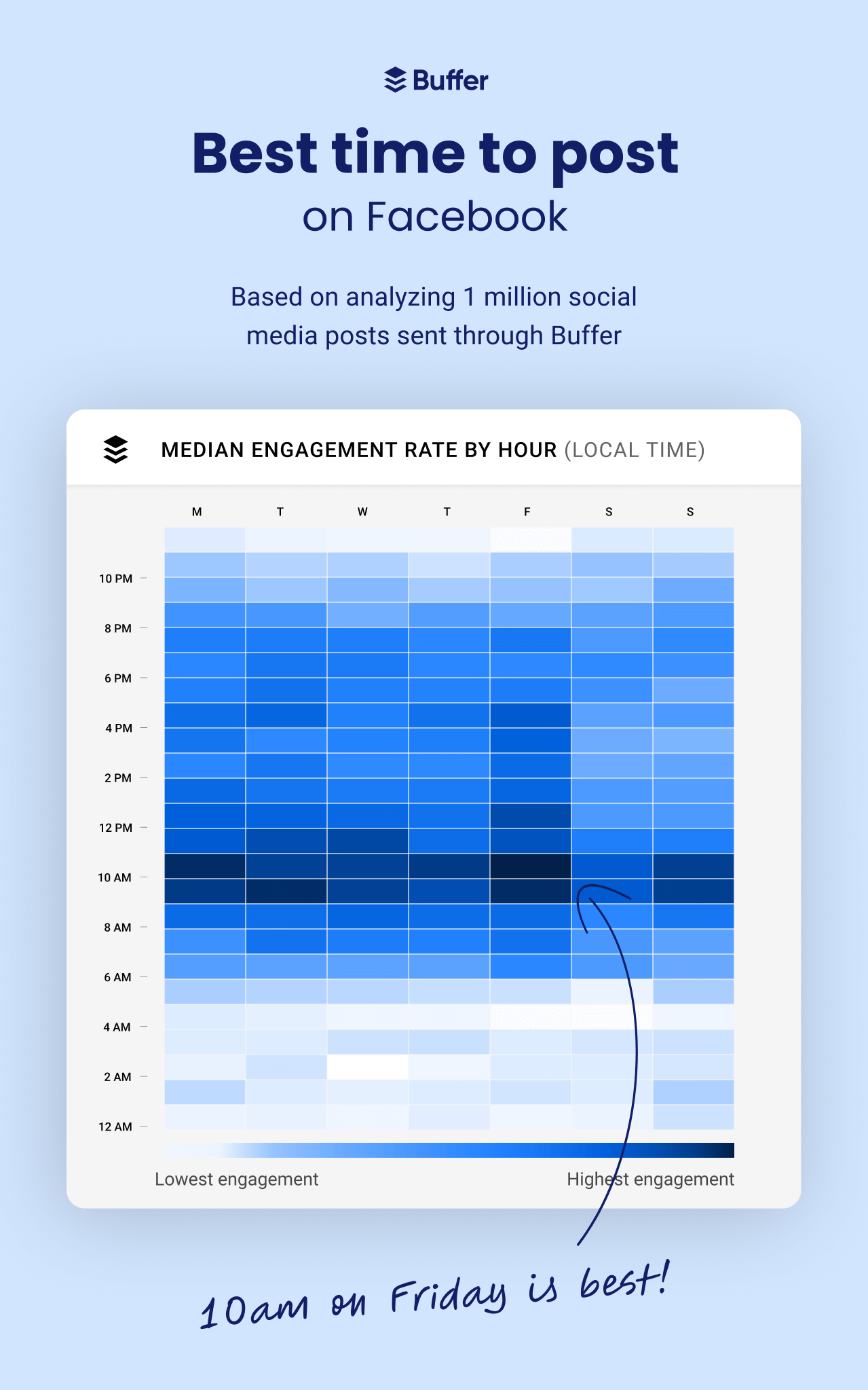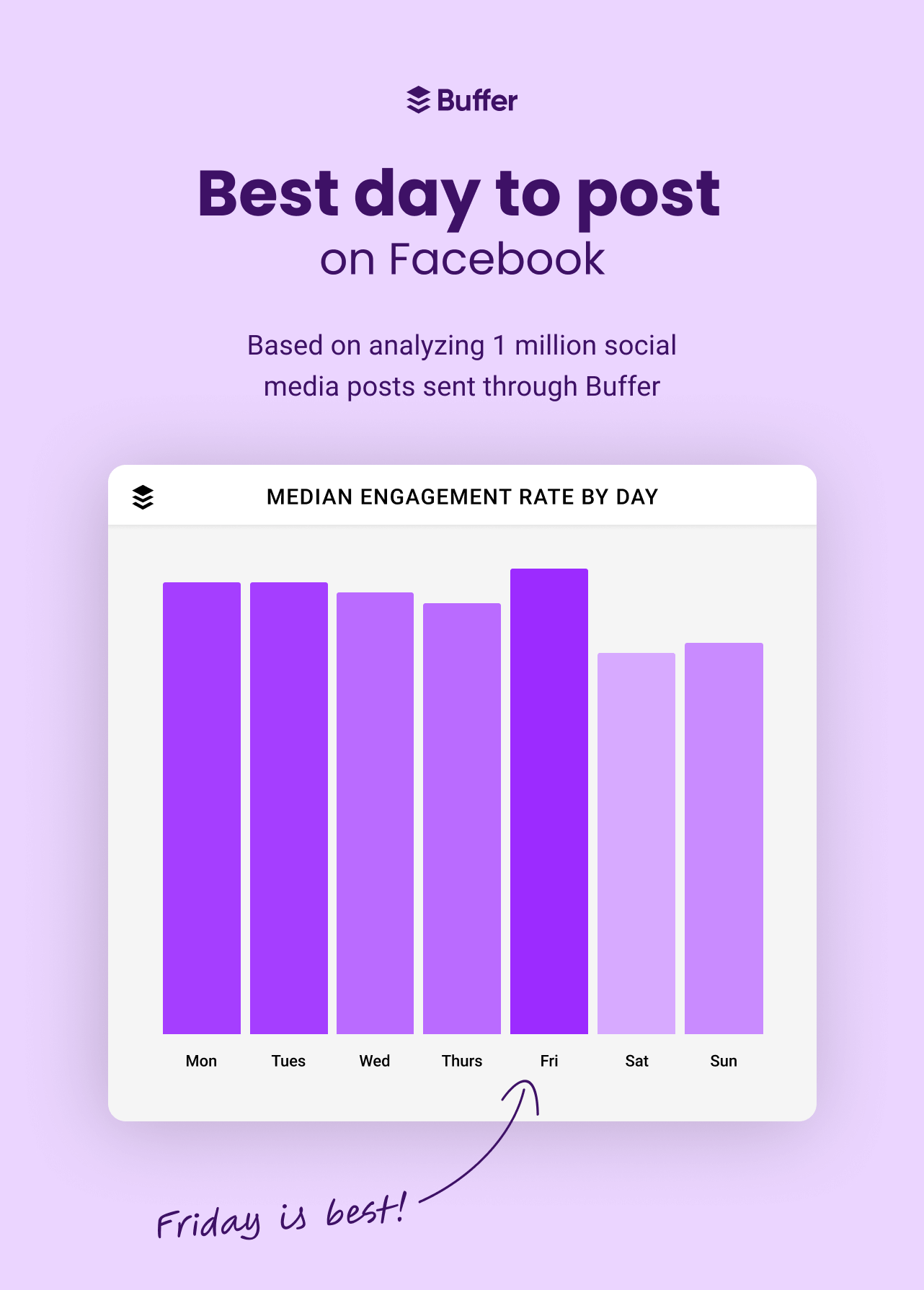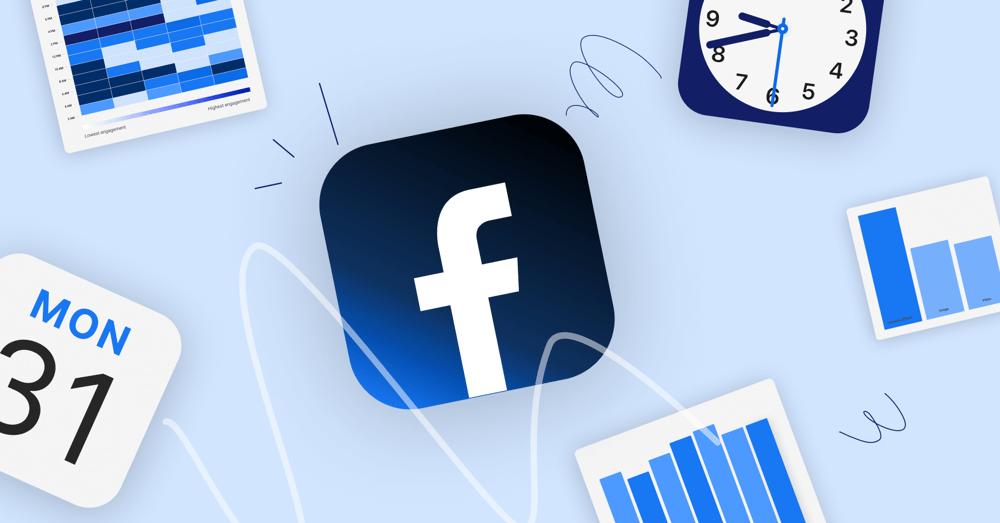Summary
We analyzed more than 1 million Facebook posts sent through Buffer to pinpoint the best time, day, and post format for maximum engagement.
You will learn
- Which days and times are generally best for posting.
- The post format that gets the most engagement.
- How to use analytics to figure out the best time to reach your specific audience.
When it comes to social media platforms, Facebook is as crowded as they come. The social network currently has a staggering 3 billion active users — so almost a third of the world population has a Facebook account they use regularly.
Crowded as it may be, it’s still a powerful social media marketing platform for businesses and creators — if you have the right social media strategy in place.
Part of that content strategy involves figuring out the best time to post on Facebook for maximum engagement. Because when it comes to the Facebook algorithm, engagement is a strong signal that your content is good, and that more people will want to see it.
The more engagement you get, the higher your reach, and the greater your chance of achieving your social media goals — whether that means driving traffic to your website, making a sale, or simply gaining a new follower.
Great! So, how do you pinpoint those high engagement times on Facebook, especially if you’re just starting out? Well, you’ve come to the right place.
The Buffer brainiacs (read: our brilliant data scientist, Julian Winternheimer) have poured over the performance of more than 1 million Facebook posts sent via Buffer by businesses, creators, and influencers in the past year to pinpoint the best time to post on Facebook, the best day to post on Facebook, plus the best-performing content on Facebook.
In short, expect plenty of helpful recommendations backed by our own data to help you optimize your posting schedule to give your social media content the best chance of success.
Ready to jump in?
Is there a best time to post on Facebook?
Let’s start with a caveat: there’s no magic, universal best time to post on Facebook, during which your content is guaranteed to go viral (if only it were that easy).
The best times to post on social media always depend on your audience — I’ll dig into how you can figure that out below.
That said, our data analysis has picked up some definitive links between posting times and high engagement rates, which could be a great starting point if you’re new to Facebook.
My advice is to use these times as a springboard for experimentation. Luckily, you have plenty of high-engagement times on Facebook to choose from as part of your marketing strategy.
The best times to post on Facebook

The best time to post on Facebook is generally 10 a.m. on Friday, according to Buffer data. Other high engagement times that come close to this peak are Mondays at 10 a.m. and Tuesdays at 9 a.m.
As you'll see from the heatmap graph above, mid-mornings on weekdays are usually the best times to post on Facebook for engagement. The darkest blue slots represent the time slots with the highest engagement rates and, we extrapolate, the best posting times. The light blue to white blocks are the time slots with the lowest engagement.
Facebook use is interesting because there isn’t an early morning, commuting, lunch break, or evening peak time every day, as we tend to see with Instagram and TikTok.
The largest demographic of Facebook users is aged 25-34 (closely followed by ages 35-44), which suggests they tend to use Facebook at the start of their workdays at 9 a.m., with engagement petering out as the weekdays wear on.
We also see more consistent higher engagement slots on Facebook on Friday as users start to slow down at work ahead of the weekend.
Weekend behavior is similar, with optimal times to post between 9 a.m. and 10 a.m. on Saturday and Sunday, though engagement is significantly lower when the workweek is over.
The best time to post on Facebook on Monday
The best time to post on Facebook on Monday is 10 a.m., though engagement on the app is solid between 8 a.m. and 1 p.m. at the start of the week.
⏰ Peak Facebook engagement time on Monday: 10 a.m.
The best time to post on Facebook on Tuesday
The best time to post on Facebook on Tuesday is 9 a.m., with engagement remaining relatively high until 11 a.m.
⏰ Peak Facebook engagement time on Tuesday: 9 a.m.
The best time to post on Facebook on Wednesday
The best time to post on Facebook on Wednesday, according to our data, is between 9 a.m. and 11 a.m.
⏰ Peak Facebook engagement time on Wednesday: 9 a.m.
The best time to post on Facebook on Thursday
The best time to post on Facebook on Thursday is 10 a.m., though 9 a.m. offers another solid engagement slot for your posting schedule.
⏰ Peak Facebook engagement time on Thursday: 10 a.m.
The best time to post on Facebook on Friday
The best time to post on Facebook on Friday is 10 a.m., the time slot that tends to receive the most engagement of the week. The rest of the day is promising, too, with another (slightly lower) peak at 9 a.m. Activity on the platform lasts a little longer on Friday, all the way up until about 4 p.m.
⏰ Peak Facebook engagement time on Friday: 10 a.m.
The best time to post on Facebook on Saturday
The best time to post on Facebook on Saturday is between 9 a.m. and 10 a.m., though engagement pales in comparison to the rest of the week.
⏰ Peak Facebook engagement time on Saturday: 9 a.m.
The best time to post on Facebook on Sunday
The best time to post on Facebook on Sunday is also between 9 a.m. and 10 a.m., with engagement generally higher than it is on a Saturday.
⏰ Peak Facebook engagement time on Sunday: 9 a.m.
This is where social media scheduling tools like Buffer really shine. Experiment by systematically going through the times on the list above, scheduling posts in those slots, and then tracking their performance to see what works best for your specific audience.
What is the best day of the week to post on Facebook?

The best day of the week to post on Facebook is Friday, when you’ll find solid engagement on the app from about 9 a.m. all the way through until 4 p.m. (though your best bet is definitely sharing content in that peak 10 a.m. time slot). Monday and Tuesday are also great days to post on Facebook, with a slight dip happening midweek.
When is the worst day of the week to post on Facebook? Saturday is the worst time, when engagement is significantly lower than the rest of the week. Sundays are also best avoided for solid engagement and reach.
The best type of content to post on Facebook

Video is the best-performing content on Facebook, which is not surprising, given how much Meta has invested into making Facebook “the best place for people to find and enjoy videos online.”
The introduction of Facebook Reels in 2022 has been a massive success, and these short-form, portrait-style videos are a must if you’re looking to reach new audiences.
That said, posts that include images or photos are hot on the heels of video, followed by text-only posts.
The worst-performing content on Facebook’s News Feed is link-only posts (also not surprising, given that Facebook wants to keep its users in the app).
That said, if you are looking to share links to drive traffic to an external site, Facebook may still be the best place for it. As part of our data analysis, we reviewed the performance of link-only posts on Facebook, X (formerly Twitter), and LinkedIn. Links on Facebook tend to get five times more clicks than those posted on LinkedIn and four times more than those posted on X.
The best time for you to post on Facebook
While the post times above are a great jumping-off point, they may not necessarily reflect the habits of your specific audience — which is where figuring out your unique best time to post on Facebook comes in. Pinpointing times that your audience is more likely to be active and engaging is an important part of social media management.
I’m going to walk you through two ways to do this:
- Facebook Insights
- Buffer analytics
How to find your best time to post on Facebook with Insights
Unfortunately, Facebook axed the ability to see when your fans are online with an update to their in-app metrics, so you’ll need to do this manually.
If you’ve been posting on Facebook for a while, you’ll have plenty of metrics to explore. If not, I suggest using the posting times above for about one month, and then following the steps below.
Here’s the process I’d recommend:
- To access your Facebook Insights, make sure you’re logged in via your Facebook Page, not personal profile (click on your profile picture on the top right, then choose your Page from the drop-down menu to switch).
- Click on Professional dashboard from the menu on the left.
- Click Content, also on the left.
- Here, you’ll find a list of all the posts you’ve shared within a specific time frame. I’d recommend selecting ‘Last 90 days’ on the top right.
- Also on the top right, click on Date, then choose Post reach. This will sort your posts by the ones with the highest reach, with the most successful posts at the top. (Be sure to only use posts you haven’t boosted to get a sense of organic reach.)
- Go through the top ten posts, making a note of a) the day and time of day the content was published and b) the content type (video, photo, text?).
- Choose Engagement via the sort button on the top right and repeat the process with the top ten posts. You’ll likely find a lot of duplicates.
- Go through these lists and look for any patterns. Are there a lot of posts shared on a specific day on these lists? A specific time of the day? Even broad trends, like the fact that most of the posts are shared in the morning, may be helpful. If no clear patterns emerge, repeat step 6 and 7 above, but choose 20 or even 30 posts.
How to find your best time to post on Facebook with Buffer
Buffer is a social media management tool that does the math for you. Rather than just showing you the numbers, Buffer will pinpoint the best day for you to post on Facebook based on your historical performance on the platform.
To access these numbers, you’ll need to make sure:
- You have a Facebook page or group connected as a channel in Buffer. Follow this guide to connect a Facebook Page and this guide to connect a Facebook group.
- You’re on Buffer’s Essential, Team, or Agency plan. The plans start at $6 per month per channel, and you can try any of them for free for 14 days to make sure it’s right for you. Here’s a look at Buffer’s pricing.
All set? From there, finding your best day to post on Facebook is simple.
- Click on Analytics in the top menu
- Select Facebook from your channel list on the left
- Choose Answers
Here, Buffer will not only tell you the best day to post on Facebook, but also the best type of post to share and how often you should post for your target audience.
Your checklist for high-performing Facebook posts
Figuring out the best time to post on Facebook can be helpful, but it’s not the ultimate secret to Facebook success (again, if only it were that simple!).
As we unpack in our guide to the Facebook algorithm, there are plenty of other things you can do to give your content the best possible chance of reaching more people. Here’s a high-level overview:
- Share content that prompts conversations: Producing high-quality content should always be your priority on social media. Tap into your Facebook Insights or analytics in Buffer to stay on top of the content that resonates the most with your audience. Remember: Facebook likes authentic accounts that contribute to their community and create meaningful interactions.
- Cultivate authentic relationships with your fans: Reacting and replying to comments and always responding timeously to DMs is only half the battle — be sure to be thoughtful and authentic in your replies to really connect with your audience.
- Experiment with different content types: While video may perform best generally, your target audience might respond better to something else. Text, photos, GIFS, Reels — be sure to try them all more than once.
- Tap into user-generated (UGC) content and mentions: When people tag you in posts, take notice: this is a perfect opportunity for sharing their content as user-generated content — with their permission, of course.
- Aim to be on users' 'Favorite' lists: Facebook users can take more control of their feeds with the Favorite list feature. Encourage your fans to add you to that list so they never miss your content.
- Don’t resort to clickbait or engagement bait: Clickbait is exaggerated, over-sensationalized content that doesn’t deliver on its promise. Engagement bait uses captions or photos that contain phrases like, “Like this if you like dogs better, share this if you like cats better.” Facebook regularly updates its algorithm to downrank content like this.
- Verify all the news you share: Another thing the Facebook algorithm doesn’t like: fake news. Facebook is vigilant in identifying misinformation and takes strict action against violators, potentially leading to removal from the platform.
- Stick to Facebook's Community Standards: Facebook takes its Community Standards seriously. The algorithm is pretty good at weeding out posts that violate these rules, but even if a post manages to skirt under the radar, Facebook users can report it and have it taken down anyway. Getting strikes against your account like this could impact future content performance.
When in doubt, always remember: Facebook’s algorithm values what users value.
“Facebook's goal is to make sure that you see posts from the people, interests, and ideas that you find valuable,” the company says. “Whether that content comes from people you're already connected to or from those you may not yet know.”










